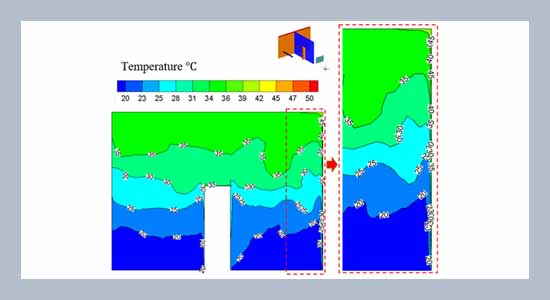REFERENCES
- Ahmed, A.Q. 2017. Modelling thermal comfort and energy saving enhancements in an office room served by stratified air distribution systems. University of Leicester.
- Ahmed, A.Q., Gao, S. 2015. Thermal comfort and energy saving evaluation of a combined system in an office room using displacement ventilation. International Journal of Mechanical and Mechatronics Engineering, 9, 1101–1106.
- Ahmed, A.Q., Gao, S. 2017. Numerical investigation of height impact of local exhaust combined with an office work station on energy saving and indoor environment. Building and Environment, 122, 194–205.
- Ahmed, A.Q., Gao, S., Kareem, A.K. 2016. A numerical study on the effects of exhaust locations on energy consumption and thermal environment in an office room served by displacement ventilation. Energy Conversion and Management, 117, 74–85.
- Ahmed, A.Q., GAO, S., Kareem, A.K. 2017. Energy saving and indoor thermal comfort evaluation using a novel local exhaust ventilation system for office rooms. Applied Thermal Engineering, 110, 821–834.
- Ahn, B.-L., Kim, J.-H., Jang, C.-Y., Leigh, S.-B., Jeong, H. 2016. Window retrofit strategy for energy saving in existing residences with different thermal characteristics and window sizes. Building Services Engineering Research and Technology, 37, 18–32.
- Al-Shohani, W.A.M., Ahmed, A.Q., Khaleel, A.J., Dakkama, H., Obaida, H.M., Fayyad, T.H. 2019. Energy saving by using a local ceiling spot air distribution system in an equipped office room. International Journal of Renewable Energy Research (IJRER), 9, 1976–1982.
- Al-Shohani, W.A.M., Ahmed, A.Q., Khaleel, A.J., Dakkama, H., Obaida, H.M., Fayyad, T.H. 2020. Evaluation of using the ceiling and wall spots ventilation system on indoor thermal environment. IOP Conference Series: Materials Science and Engineering, IOP Publishing, 012056.
- Chen, H., Moshfegh, B., Cehlin, M. 2013. Investigation on the flow and thermal behavior of impinging jet ventilation systems in an office with different heat loads. Building and Environment, 59, 127–144.
- Cheng, Y., Niu, J., Liu, X., Gao, N. 2013. Experimental and numerical investigations on stratified air distribution systems with special configuration: Thermal comfort and energy saving. Energy and buildings, 64, 154–161.
- Chiang, W.-H., Wang, C.-Y., Huang, J.-S. 2012. Evaluation of cooling ceiling and mechanical ventilation systems on thermal comfort using CFD study in an office for subtropical region. Building and Environment, 48, 113–127.
- Duan, Q., Wang, J. 2019. A parametric study of the combined effects of window property and air vent placement. Indoor and Built Environment, 28, 345–361.
- Fanger, P.O. 1970. Thermal comfort. Analysis and applications in environmental engineering. Thermal comfort. Analysis and applications in environmental engineering.
- Gan, G. 1995. Evaluation of room air distribution systems using computational fluid dynamics. Energy and buildings, 23, 83–93.
- Gillingham, K., Newell, R.G., Palmer, K. 2009. Energy efficiency economics and policy. Annual Review of Resource Economics, 1, 597–620.
- Hawendi, S., Gao, S., Ahmed, A.Q. 2019. Effect of heat loads and furniture on the thermal comfort of an isolated family house under a naturally ventilated environment. International Journal of Ventilation, 1–26.
- Heidarinejad, G., Fathollahzadeh, M.H., Pasdarshahri, H. 2015. Effects of return air vent height on energy consumption, thermal comfort conditions and indoor air quality in an under floor air distribution system. Energy and Buildings, 97, 155–161.
- Horikiri, K., Yao, Y., Yao, J. 2012. Numerical study of unsteady airflow phenomena in a ventilated room. ICHMT digital library online, Begel House Inc.
- Horikiri, K., Yao, Y., Yao, J. 2014. Modelling conjugate flow and heat transfer in a ventilated room for indoor thermal comfort assessment. Building and Environment, 77, 135–147.
- Horikiri, K., Yao, Y., Yao, J. 2015. Numerical optimisation of thermal comfort improvement for indoor environment with occupants and furniture. Energy and Buildings, 88, 303–315.
- Kuo, J.-Y., Chung, K.-C. 1999. The effect of diffuser's location on thermal comfort analysis with different air distribution strategies. Journal of Thermal Envelope and Building Science, 22, 208–229.
- Lam, J.C., Chan, A.L. 2001. CFD analysis and energy simulation of a gymnasium. Building and Environment, 36, 351–358.
- Normalisation, O.I.D. 1994. Moderate thermal environments: Determination of the PMV and PPD indices and specification of the conditions for thermal comfort, International Organization for Standardization.
- Park, H.-J., Holland, D. 2001. The effect of location of a convective heat source on displacement ventilation: CFD study. Building and environment, 36, 883–889.
- Pérez-Lombard, L., Ortiz, J., Pout, C. 2008. A review on buildings energy consumption information. Energy and buildings, 40, 394–398.
- Srebric, J., Chen, Q. 2002. Simplified numerical models for complex air supply diffusers. Hvac&R Research, 8, 277–294.
- Vanhoutteghem, L., Skarning, G.C.J., Hviid, C.A., Svendsen, S. 2015. Impact of façade window design on energy, daylighting and thermal comfort in nearly zero-energy houses. Energy and Buildings, 102, 149–156.
- Wan, M., Chao, C. 2005. Numerical and experimental study of velocity and temperature characteristics in a ventilated enclosure with underfloor ventilation systems. Indoor air, 15, 342–355.
- Xu, Y., Yang, X., Yang, C., Srebric, J. 2009. Contaminant dispersion with personal displacement ventilation, Part I: Base case study. Building and Environment, 44, 2121–2128.
- Yakhot, V., Orszag, S., Thangam, S., Gatski, T., Speziale, C. 1992. Development of turbulence models for shear flows by a double expansion technique. Physics of Fluids A: Fluid Dynamics, 4, 1510–1520.
- Yuan, X., Chen, Q., Glicksman, L.R., Hu, Y., Yang, X. 1999. Measurements and computations of room airflow with displacement ventilation. Ashrae Transactions, 105, 340.






